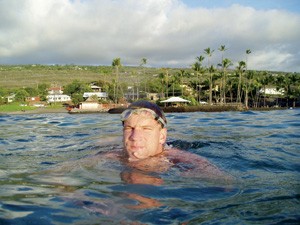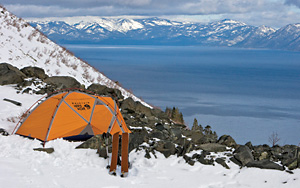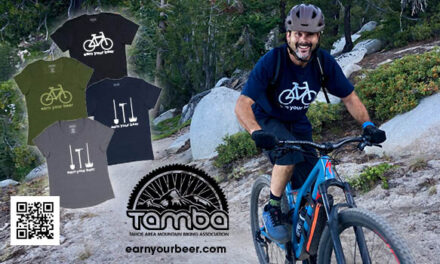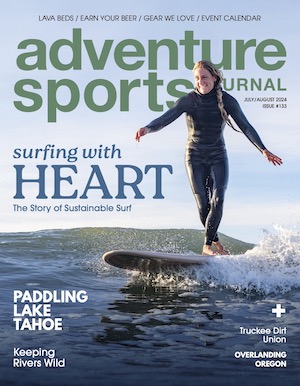- Tahoe’s Nevada Beach Tops the List of Hard-to-Book Campgrounds - 07/17/2024
- Cannabis Watershed Protection Program Cleans Up Illegal Grow Sites - 07/10/2024
- French Fire - 07/05/2024
Long-distance swimmer Jamie Patrick dips into the water to break records and save our blue planet
Story by Bruce Willey

Photo by Matt Richardson.
People like Lance Armstrong, Lynn Hill, and Shawn White were put on this world to remind most of us we are mere mortals. Add another to the list of super achievers to humble and motivate —swimmer Jamie Patrick.
Yet to call him a swimmer is a gross understatement. He’s one of the world’s elite long-distance, open-water athletes intent on not just records, but raising awareness about the planet’s water supply in the process.
This June, Patrick, 39, will begin his quest for what he is calling the T3 Series. He will begin by swimming one length of Lake Tahoe, 22 miles, to break the fastest crossing. Then later in the summer he will swim two lengths of Lake Tahoe, 44 miles, to be the first to accomplish a double crossing.
And then finally, Patrick will swim Lake Tahoe not once, not twice, but three times to raise awareness for water issues, something us mere mortals must pay attention to lest we live up to our name. He’s dubbed the 66-mile swim aptly enough The Tahoe Triple and it will take him over 30 hours in the cold (55-60 degree) water sans wetsuit. If he’s successful he would beat the world record for the longest high-altitude swim.
But this is just a warm-up of sorts. His ultimate goal is to swim the “Ocean’s Seven.” Like the mountaineer’s version of the seven highest summits on each continent, the project reads like a pelagic geography lesson: The Irish Channel, the Cook Strait, the Moloka’i Channel, the English Channel, the Catalina Channel, the Tsugru Channel, and the Strait of Gibralter.
Patrick, a San Francisco-based athlete, already has more than 50 open water swims, 75 triathlons, a quadruple Ironman Triathlon, and a Triple Ironman to his name.
“He has merged his love for water and ultra athletics to create positive changes in the world,” says friend Jaimal Yogis, author of “Saltwater Buddha” who recently swam to Alcatraz and back with Patrick. “And that’s what it’s all about. If anyone can complete the Tahoe Triple and the Oceans Seven, it’s Jamie.”
ASJ caught up with Patrick after a training session.
ASJ: What was the inspiration behind this current project? How are you training for it?
JP: I have been a swimmer all my life. From the age of seven, I have been in the water. Swimming competitively through college, I then began racing triathlons. Swimming has given me many things in life. Most of all happiness. The Tahoe Triple, T3, was born out of my desire to give back to the thing that has given me so much — water. In the process of preparing for this goal, breaking the high altitude record for open water swimming by swimming three lengths of Lake Tahoe, I will be completing what I am calling the T3 Series. This will entail two swims prior to The Tahoe Triple — a single crossing and a double crossing of Lake Tahoe.
ASJ: Tell us more about the film. What is it about?
JP: I have partnered with filmmaker Martin Sundberg. Martin’s passion for water is no different from mine. Our goal, through our film is to help ultimately create a relationship between those that watch our film and water. Rather than create a typical documentary about the epic problems our society faces when it comes to pollution, global warming, etc., we hope to inspire those that view our film to take their own action. We want to show how individual actions, simple and/or record breaking, can inspire others to act and ultimately catalyze change. We believe that recreation is one of the most effective ways of stimulating environmental stewardship. Through recreation, we become better acquainted with our natural resources. Through that relationship, we begin stewarding those resources and become motivated to ensure their longevity. In this case, the resource is water. Through my swimming and Martin’s visual presentation for water, we hope to inspire those that watch our film to take their own action.
ASJ: What’s it like swimming such a big lake? What goes through your mind on a big swim?
JP: Swimming such distances is both physically and mentally demanding. The body goes through periods of extreme pain. Like other ultra-distance athletes, overcoming these obstacles will ultimately result in success. Unlike ultra-runners or ultra-cyclists, ultra-swimmers lack the visual stimulation that one gets while running or cycling. Having your face in the water for up to 35 hours with nothing to look at is very difficult. The mind begins to play tricks. Preparing mentally is the most important part of attempting something of this magnitude.
You can read more about Jamie’s adventure at www.thetahoetriple.com













